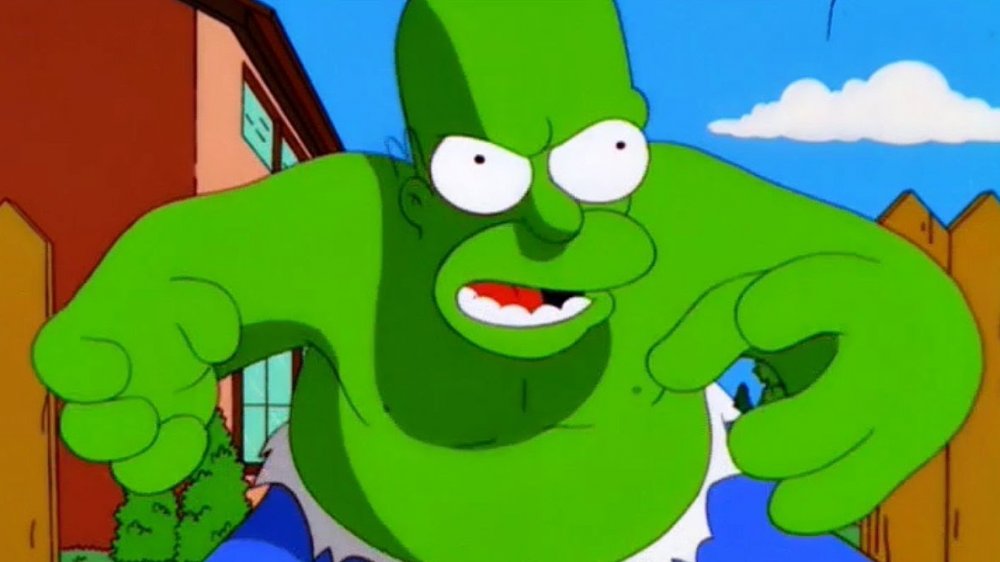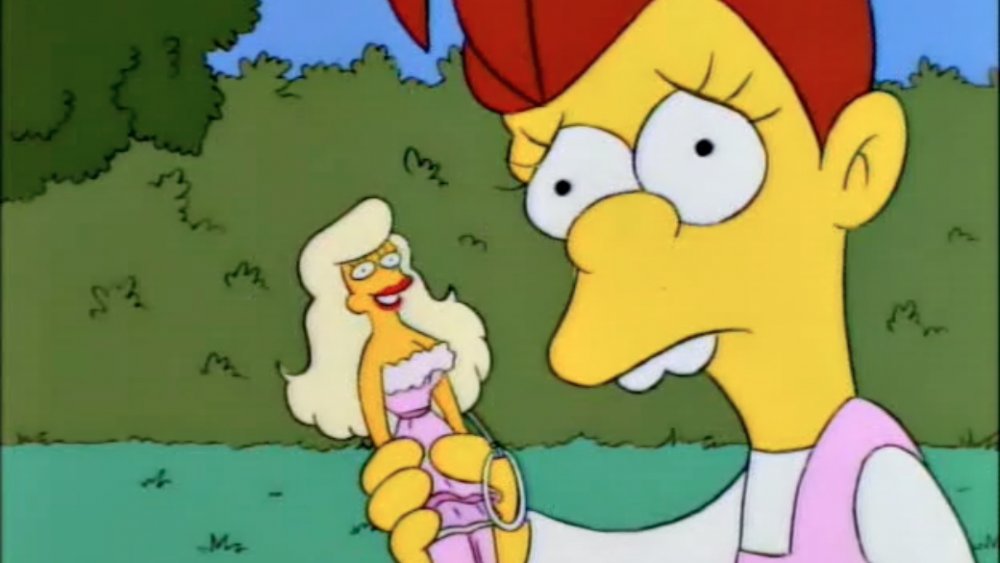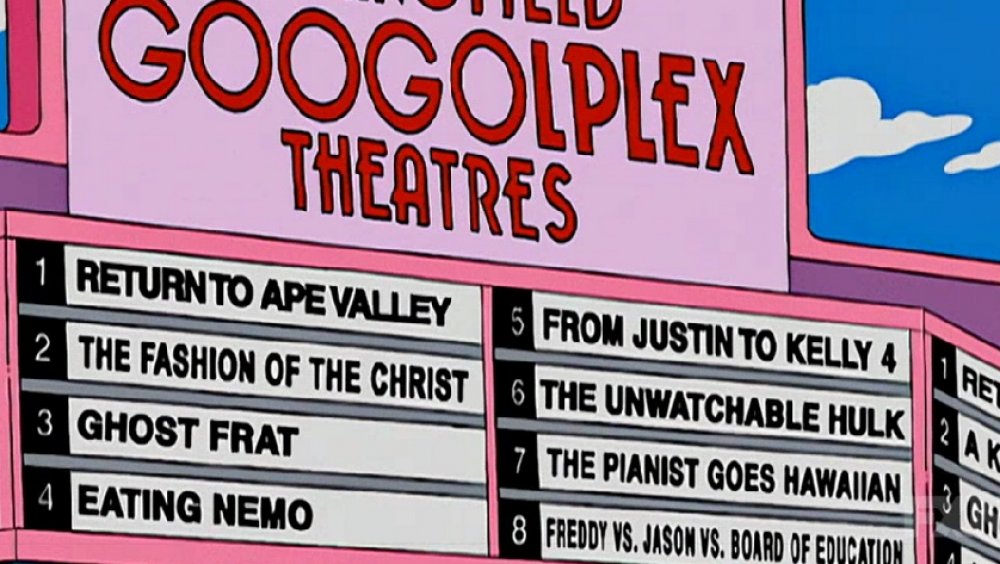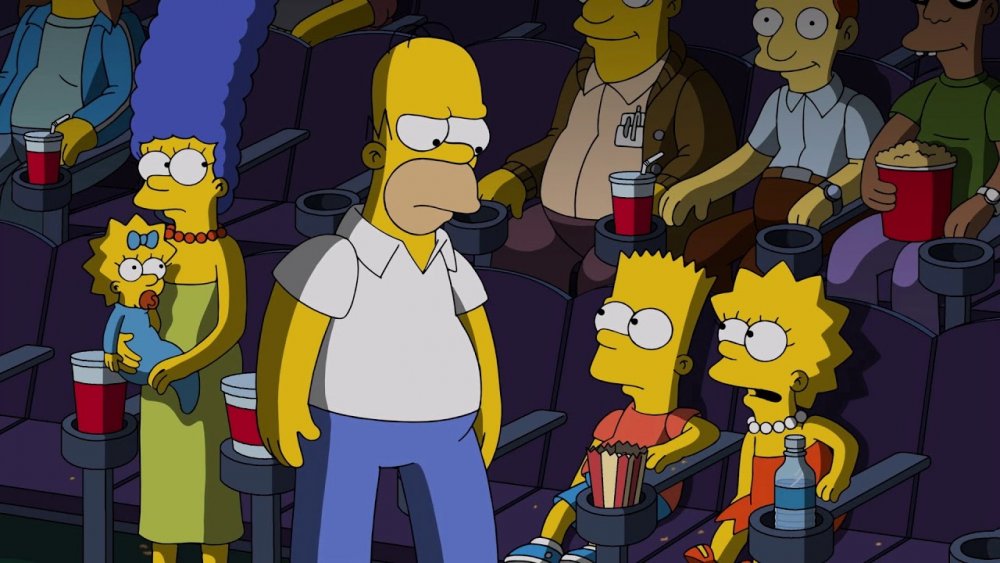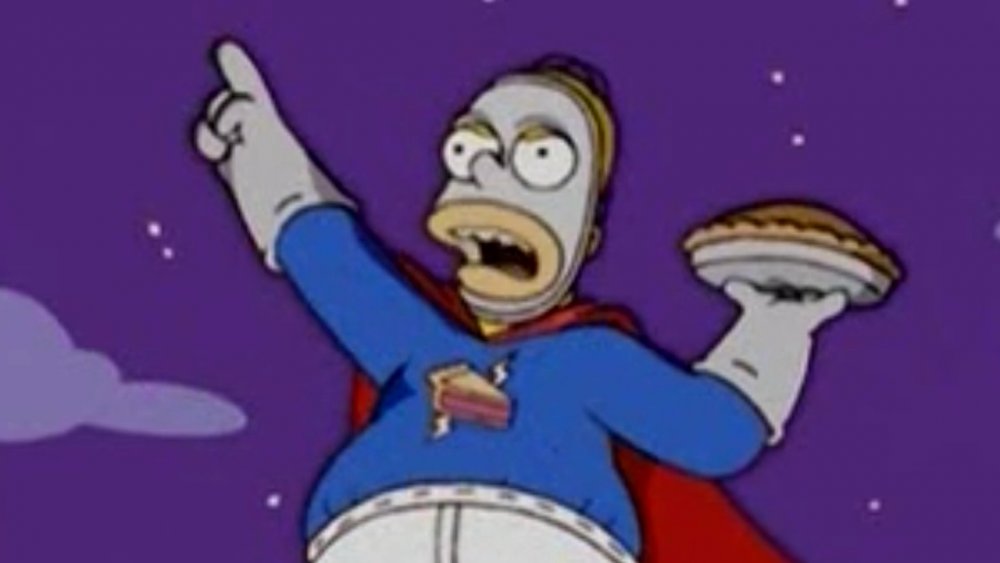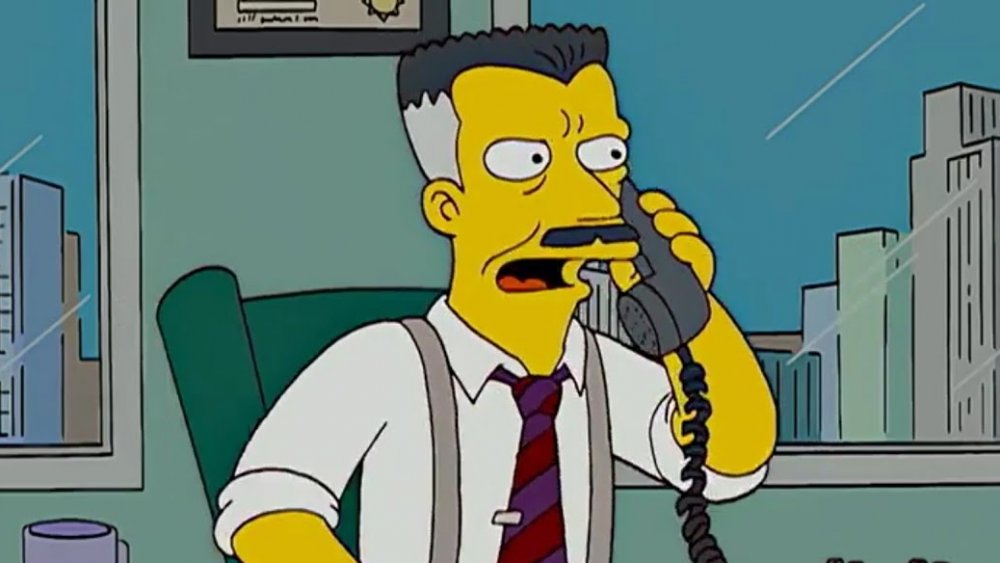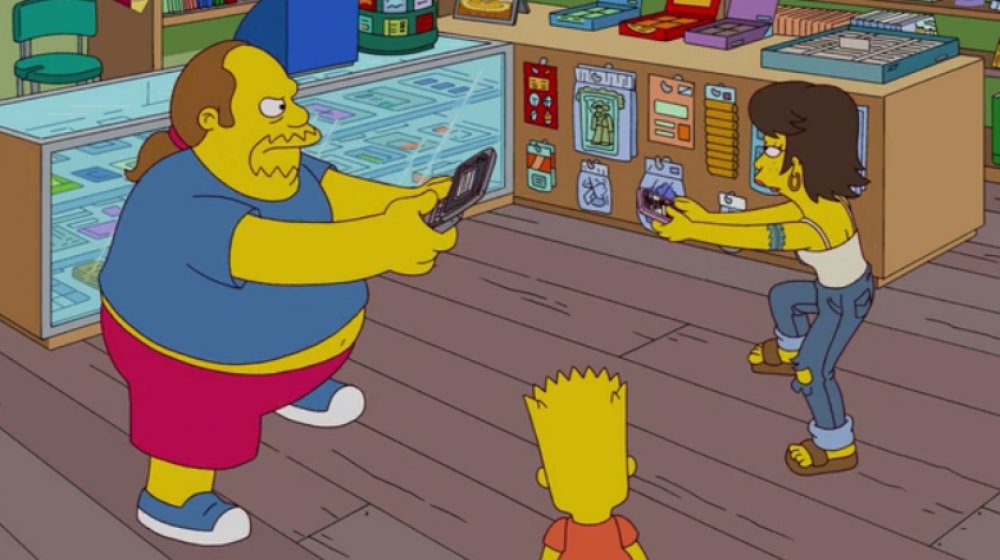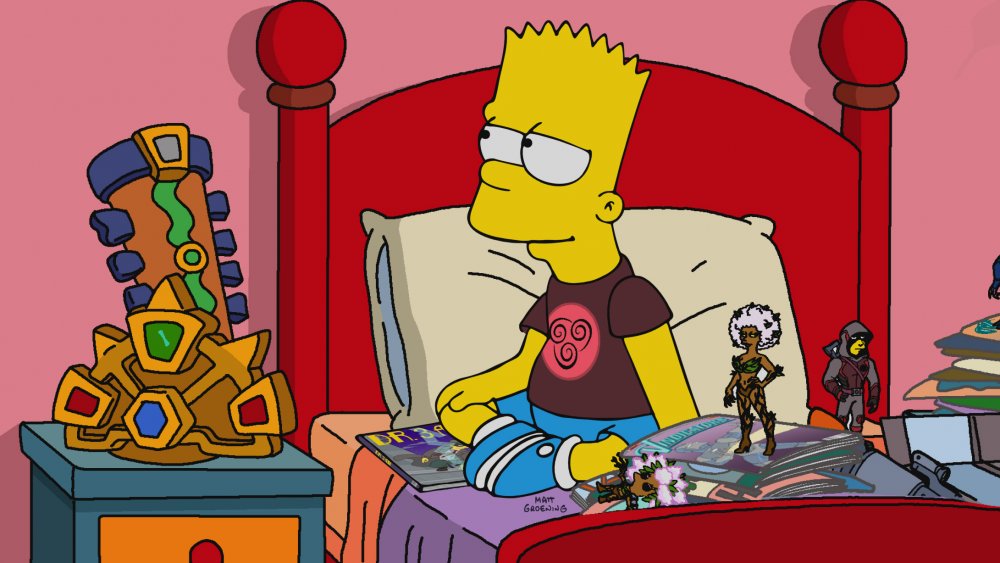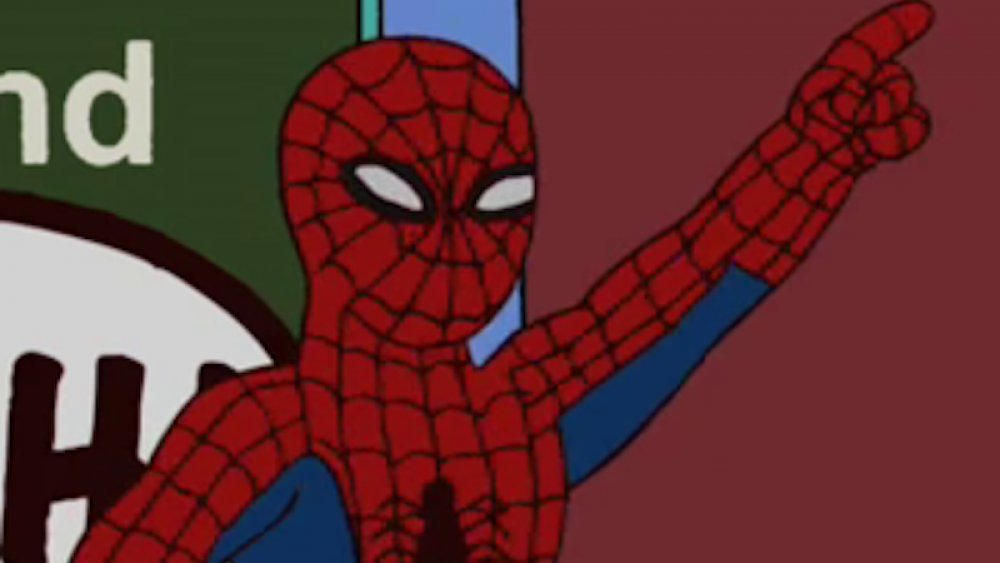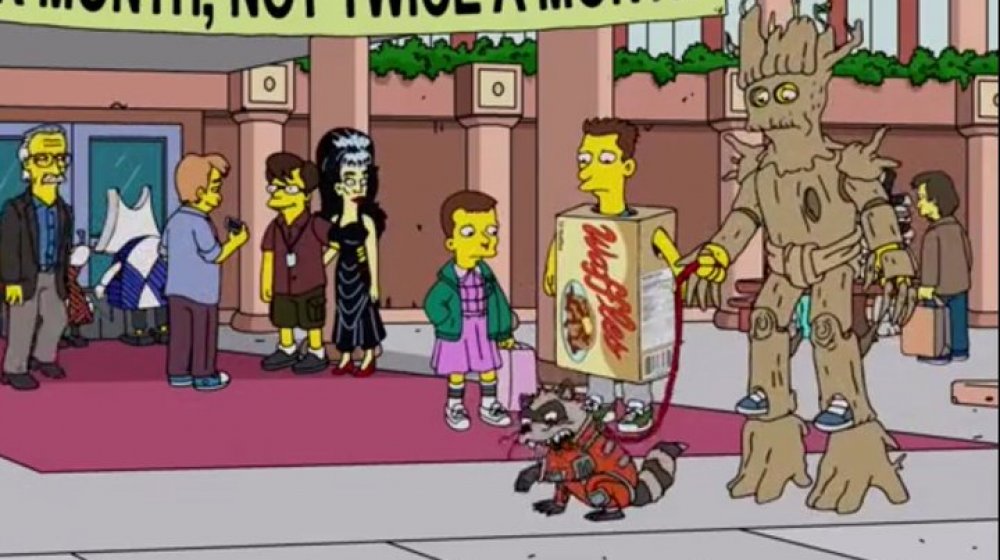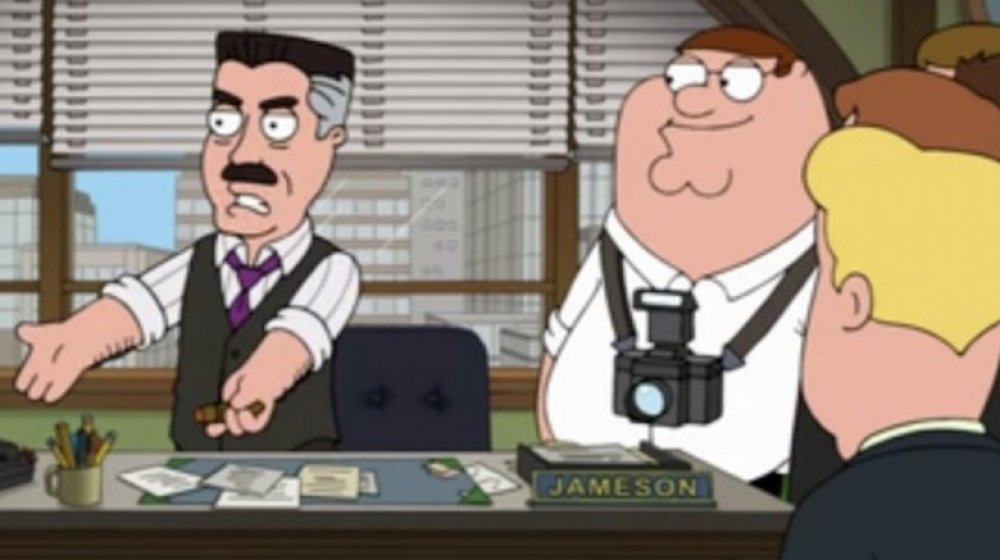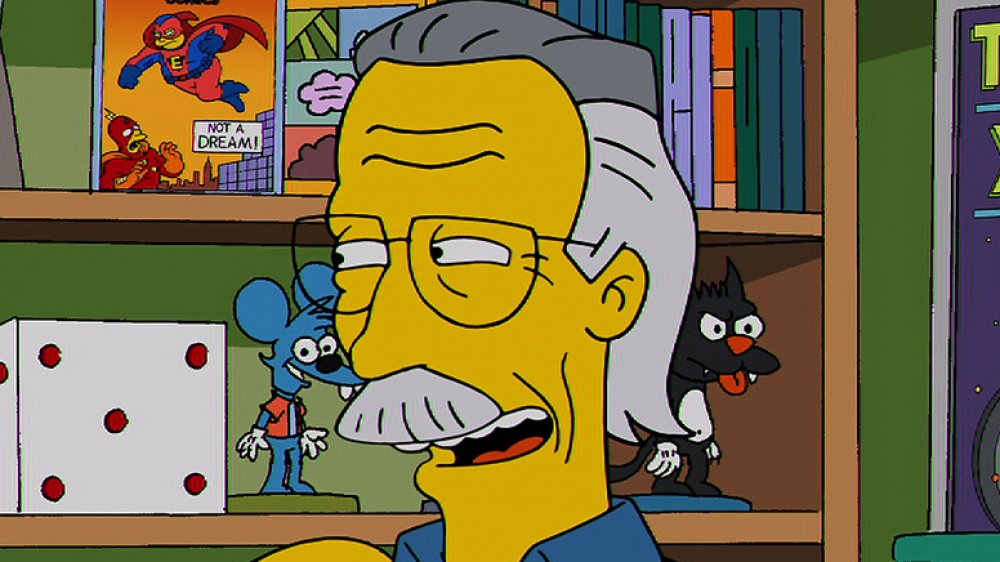Marvel References You Missed In The Simpsons
The Simpsons isn't just the longest-running TV comedy in American history. It's also one of the most influential. Debuting on Fox in 1989, The Simpsons showed that animated fare for adults was viable and that millions had an appetite for satire. The Simpsons has made fun of most every aspect of society, from politics and consumerism to health care and pop culture. And after more than 30 years, there's little The Simpsons hasn't skewered, and that includes the entertainment juggernaut of Marvel, purveyor of comics, films, and other popular pastimes. The show teases the house that Stan Lee built (and that the Marvel Cinematic Universe turned into a popular movie franchise) quite often. Some of these nods are general and easy to get, while others are highly specific, obscure, or brief. For whatever reason, these little Easter eggs are so well-hidden that they're easy to miss. Here are some of the times when The Simpsons laid out references to Marvel that you just might not have spotted.
Malibu Stacy does whatever a spider can
"Lisa vs. Malibu Stacy" from 1994 is one of the earliest and best "crusading Lisa" episodes of The Simpsons, in which the sensitive, political, and staunchly feminist middle Simpson child strikes back against the manufacturers of a culturally dominant but fairly sexist Barbie-like doll called Malibu Stacy. Lisa is otherwise a huge Malibu Stacy fan and collector, but she becomes deeply offended by a new talking Malibu Stacy doll with a voice chip that utters misogynistic phrases. (For example, there's, "Thinking too much gives you wrinkles," "Let's make cookies for the boys," and, "Don't ask me, I'm just a girl.")
When ranting about her problems with the doll in front of a bunch of other girls her age, a classmate named Celeste notes that there's something wrong with her Malibu Stacy. She pulls its string, and it says, "My Spidey sense is tingling! Anybody call for a webslinger?" This is of course the language and jargon used by Marvel Comics character Spider-Man. It's also a reference to an early '90s group called the Barbie Liberation Organization, which surreptitiously replaced the voice chips in Teen Talk Barbie ("Math is hard!") in favor of ones from talking G.I. Joe dolls ("Eat lead, Cobra!").
Giving Marvel credit where credit is due
The Simpsons is loaded with sight gags, like signs that only pop onto the screen for a fraction of a second, making lots of these jokes easy to miss. (For example, Springfield Dental Complex's reader board states, "No matter how you brush you're doing it wrong," and then there's one that goes, "Sprawl*Mart: Not a Parody of Wal*Mart.") And whenever the Simpson family heads to a movie, viewers are in for a treat, as the marquee outside the Googolplex is likely to boast a lot of joke movie titles.
And yeah, Marvel gets mentioned a couple of times. In the 2004 episode "The Ziff Who Came to Dinner," there's a brief shot of the eight-screen theater's sign, offering such era-specific fake films as The Fashion of the Christ, Eating Nemo, and The Unwatchable Hulk. That's a reference to the 2003 Hulk film, the first appearance of the angry green guy on the big screen, which wasn't a huge critical hit.
Similarly, in the 2018 episode "3 Scenes Plus a Tag from a Marriage," the Simpsons see a film at the Capital City Googolplex, and alongside titles like Transformers: Fatigue and The Lego Get Out Movie, there's an MCU-type entry listed on the marquee. It's Marvel: Letters to the Editor, a dig at how the company has used seemingly everything from its comics canon as movie fodder.
There's a mid-credit sequence in the middle of an episode
When the Simpsons decide to check out a film called Marvel: Letters to the Editor at their local theater, viewers don't get to see much of the movie. However, they do get to enjoy the end titles, which provide some quick-shot Simpsons visual jokes. Credits for the fake MCU movie file past, such as "Mr. Downey Jr.'s Moustache by Frederico's of Hollywood," which refers to Tony Stark's facial hair in Iron Man. Plus, there's the warning that the "so-called 'Iron Man' may contain traces of tungsten." The credits also mention that Hulk-playing Mark Ruffalo has an anger coach named "Edgar 'Rage' Raginsky," and like a real Marvel movie, there's even a Stan Lee cameo with the line, "Stan Lee created by Stan Lee's parents."
Marvel movies are never really over at the credits, and this one is no exception. The Simpsons makes fun of the MCU's love of mid-credit and post-credit sequences that reveal huge plot twists and whet audience appetites by setting up future Marvel movies. Marvel: Letters to the Editor has a mid-credit scene that brings a beloved character back from the dead. In this case, it's Peter Parker's Uncle Ben ... only now, he's unspeakably evil. After that, there's yet another sequence which sets things up for the Avengers-like superhero event team-up movie featuring "the Assemblers," titled Assemblers Assemble.
With great pie comes great responsibility
Marvel movies are often superhero origin stories, such as the 2002 Spider-Man, which tells how Peter Parker became a radioactive, wall-crawling crime-fighter. And many elements of the Sam Raimi film are gently parodied in "Simple Simpson," a 2004 episode of The Simpsons which serves as the origin story for Homer's short-lived superhero identity, Pie Man. At the county fair, Lisa enters a table-setting contest, but the judge, the obnoxious Rich Texan, thinks her project "stinks like the south end of a northbound mule" and goes about humiliating her for his own entertainment. This enrages Homer, but remembering that Chief Wiggum told him he'd go to jail if he committed another felony assault, he takes another path to revenge. He steals items from fair booths and fashions them into a crude superhero outfit, announces himself as Pie Man, and avenges Lisa by throwing a pie in the Rich Texan's face.
Before Homer can right any other wrongs, he needs a proper Pie Man costume. The show then launches into a montage of Homer drawing up ideas for his Pie Man look, then dutifully sewing one together that doesn't look quite as good as what he'd probably imagined. The whole thing is reminiscent of Peter Parker creating his own less-than-stellar initial outfit in Spider-Man. That episode has another big reference to the Raimi film, with the upside-down kiss between Pie Man and Marge.
J. Jonah Jameson got a new gig
"Moe'N'a Lisa" from 2006 is a classic episode of The Simpsons in that it gives viewers its signature mix of silly references to both highbrow culture and accessible pop culture. In the former, renowned authors Jonathan Franzen, Michael Chabon, Tom Wolfe, and Gore Vidal make voice cameos, while in the latter, there's an extended sequence involving a side character from the Spider-Verse, specifically as he was presented in the first trilogy of Spider-Man movies.
As for the plot, Lisa discovers that Moe is a dark, sad, everyman poet in the vein of Charles Bukowski, and she sends his work "Howling at a Concrete Moon" to the literary journal American Poetry Perspectives. And who happens to be the magazine's editor? Well, it's none other than the belligerent, flat-topped J. Jonah Jameson, who's apparently moved on from his job at the helm of The Daily Bugle. He's voiced by Academy Award-winning character actor J.K. Simmons, who portrayed Jameson in the Tobey Maguire Spider-Man films, as well as Spider-Man: Far From Home.
The Simpsons and Marvel mythology
References to comic books and its surrounding culture have been part of The Simpsons for decades, even back when collecting comics was a relatively obscure and niche pastime. Bart Simpson and Milhouse regularly visit Springfield's comics source, The Android's Dungeon & Baseball Card Shop, run by the usually arrogant and dismissive Comic Book Guy. However, in the 2012 Simpsons episode "Beware My Cheating Bart," characters wind up at the store not for comics but romantic refuge.
After neighborhood bully Jimbo forces Bart to escort his girlfriend Shauna to places he doesn't want to go, the two develop romantic feelings, and after they're caught kissing, they hide from Jimbo and his bully friends at The Android's Dungeon. Comic Book Guy welcomes the opportunity, telling them, "Think of this as your personal Asgard, and I the all-seeing Heimdall, guardian of the gate." That's three allusions in one sentence to Norse mythology, but since this is the Comic Book Guy, he's really referencing the Norse mythology-inspired world of Marvel's Thor. Asgard is the homeland of Thor and his fellow mighty gods, and Heimdall is the city's protector who stands guard at the gate to expel any unwanted parties.
But wait, there's one more Marvel reference in the scene. Shauna makes fun of the Comic Book Guy's weight, and he starts a flame war, quipping, "Flame on!" That, of course, is the catchphrase of the Human Torch of the Fantastic Four.
A Simpsons episode thoroughly skewers the MCU
In 2020's "Bart the Bad Guy," Bart becomes the most powerful person in Springfield, conning his way into whatever he wants by threatening to reveal spoilers for the upcoming "Marble Studios" superhero saga Vindicators: Crystal War 2: Resurgence, which he viewed on a laptop stolen from a drunken, passed-out star of the film. Obviously, the film is a sendup of Marvel Studios' Avengers: Infinity War and Avengers: Endgame, complete with a cliffhanger ending and a powerful space titan.
The episode starts with just about all of Springfield watching the first Crystal War in a theater, where the Thanos-like Chinnos comes into possession of the Doomsday App and uses it to turn the protagonists into shattering crystals. (It's not an Infinity Gauntlet, a snap of the fingers, or a mass dusting, but it's close.) Like Infinity War, the first Crystal War is overloaded with superheroes, including the goateed and "funny not too funny" Magnesium Man (Iron Man) and Airshot (he's like Hawkeye, in that he wields a sort-of-effective air gun, not a sort-of-effective bow and arrow).
While all that references modern Marvel movies, the show throws in a nod to a Marvel movie of the previous decade. During one point in the film, we hear the song "People Get Up and Drive Your Funky Soul," which is the same James Brown tune that accompanies Peter Parker's street strut in 2007's Spider-Man 3.
A Marvel reference by way of a 1970s TV reference
In "Elementary School Musical," a Simpsons episode from 2010, washed-up, self-loathing TV host Krusty the Clown achieves the unthinkable. He wins the Nobel Peace Prize. However, it's all just a ruse to get him onto a plane, which lands at The Hague, whereupon Krusty is arrested for various crimes and is set to be tried by the International Court of Justice. He'll be released only if someone can find proof that Krusty has contributed significantly to culture in any way.
Homer and Bart scramble to locate some kind of evidence of Krusty's artistic importance, and on the internet, they find a "MyTube" clip of the PBS educational show The Electric Company. The bit obviously dates to the '70s, as that's when the show aired, and a character clearly based on Easy Reader (portrayed on the original show by Morgan Freeman) shows up wearing bell bottoms and platform shoes. Krusty then appears and dances, only to get brained by a stage light. A giant "ouch" speech bubble appears above him, and Spider-Man rushes in to dance and vamp to divert attention from Krusty's injury. This is a deep Marvel cut, as a low-budget version of Spider-Man really did appear on The Electric Company in the '70s.
The Simpsons are Groot
The 2017 episode "Springfield Splendor" alludes to the title of the classic indie comic American Splendor, but on the whole, the episode satirizes all kinds of comic books and the other properties they've spawned in recent years, particularly those of Marvel Comics. After Lisa devises a confessional, autobiographical graphic novel called Sad Girl, she's invited to speak at a panel at the Springfield Bi-Mon-Sci-Fi-Con. Like real-life pop culture conventions, attendees dress like their favorite comic book characters. There's a very brief shot of a man wearing a cheap, ramshackle tree costume. Clearly, he's attempting to cosplay as Groot, the monosyllabic walking tree-man from Guardians of the Galaxy. That's confirmed by his convention companion, who's cosplaying as Rocket Raccoon. Well, not so much cosplaying because it's just an actual raccoon desperately trying to tear off its costume.
Later on in the episode, Lisa's Sad Girl gets turned into a Broadway musical, which is ostensibly a send-up of the graphic novel to Great White Way success of Alison Bechdel's Fun Home. However, the score for the Sad Girl live experience is also the score from the ill-fated Broadway musical Spider-Man: Turn Off the Dark.
When Family Guy met the Simpsons and Spider-Man
While the two shows frequently take potshots at each other, The Simpsons and Family Guy are both massively successful, long-running stalwarts of Fox's Sunday night lineup. And in 2014, worlds collided with "The Simpsons Guy," a crossover episode in which the Griffins of Family Guy visit the Simpsons' hometown of Springfield. However, the Griffins also brought along their patented absurd cutaway sequences.
In one such scene, J. Jonah Jameson — Peter Parker's newspaper boss and part of The Simpsons universe already — pops up for a Spider-Man homage. It happens when Peter Griffin recalls the time he worked at The Daily Bugle, a setup for a payoff of a throwaway line of dialogue from 2002's Spider-Man. In that film, Jameson (J.K. Simmons) remarks, "If we can get a picture of Julia Roberts in a thong, we can get a picture of this weirdo," meaning Spider-Man. That photo of the Pretty Woman star in skimpy underwear, as explained in the cutaway, came from Peter Griffin. He hands over a photo of a woman — presumably Julia Roberts — wearing low-rise jeans with underwear poking out the back.
Yeah, Stan Lee showed up in The Simpsons
The late Stan Lee was a living Marvel reference, a cheerleader for the company he started and where he helped invent dozens of characters. It's fitting then that he turned in an extended cameo — as was his policy for Marvel movies — in "I Am Furious (Yellow)," which finds Bart becoming a major player in the comics business. After Bart visits The Android's Dungeon & Baseball Card Shop to get Comic Book Guy's opinion on a character he created, Lee shows up to offer his own critique. When Bart returns to the store later, he notices that Lee is still hanging around. Comic Book Guy posits that Lee's "mind is no longer in mint condition," which is proven when he's shown trying to convince local nerd Database that an action figure of the Thing from Fantastic Four can fit into a toy Batmobile (which isn't even a Marvel property). Lee is also convinced that he's the real Incredible Hulk.
A couple of seasons later, a vision of Lee tries to convince Comic Book Guy to pursue the girl he loves. When asked for help, Lee declines, claiming, "I can only watch. I cannot interfere." That's a subtle nod to a bit said by the Watchers, Marvel characters seen in Guardians of the Galaxy and Fantastic Four.
